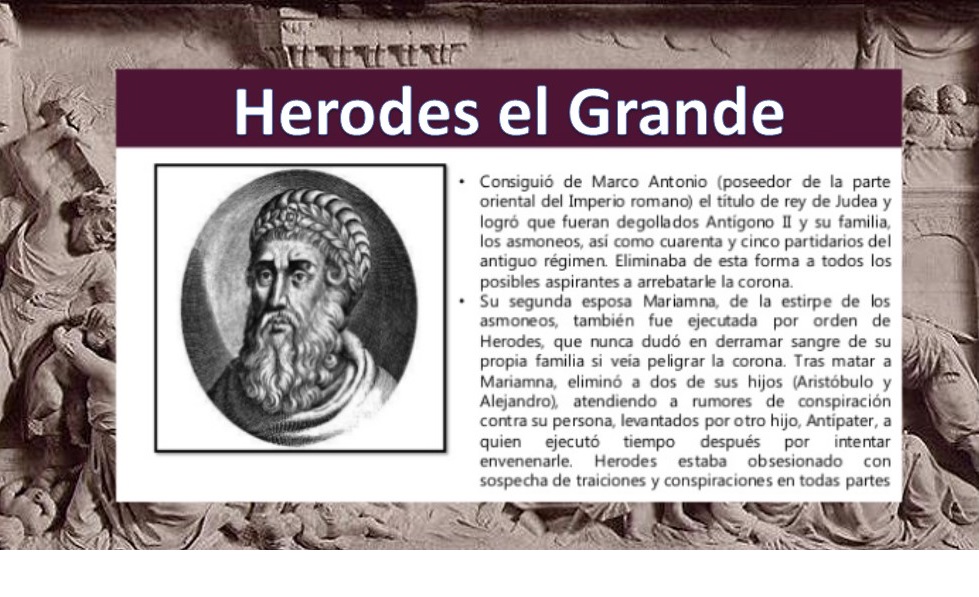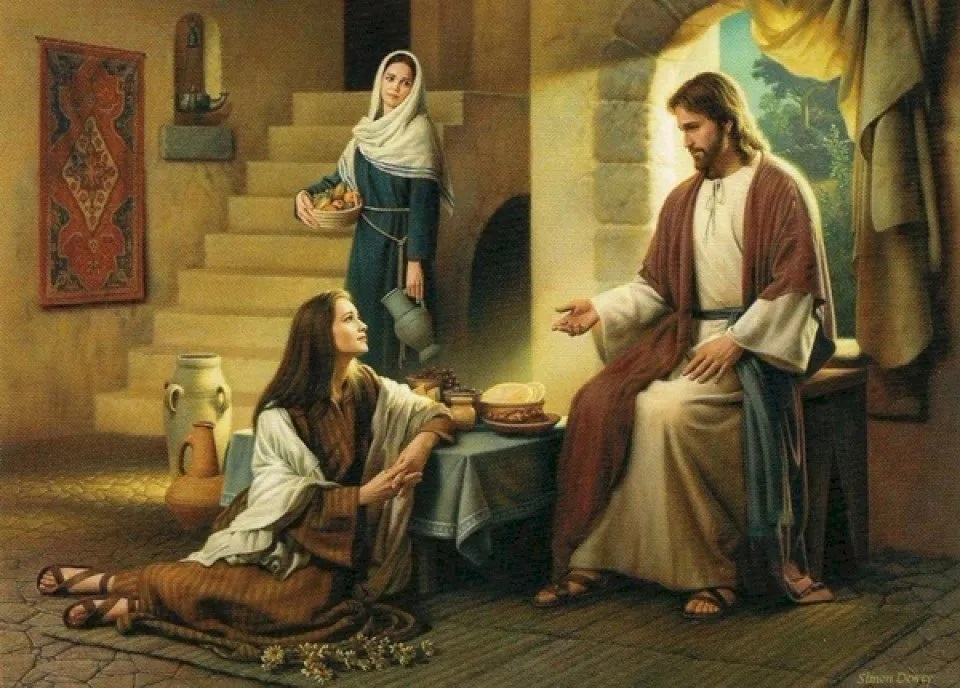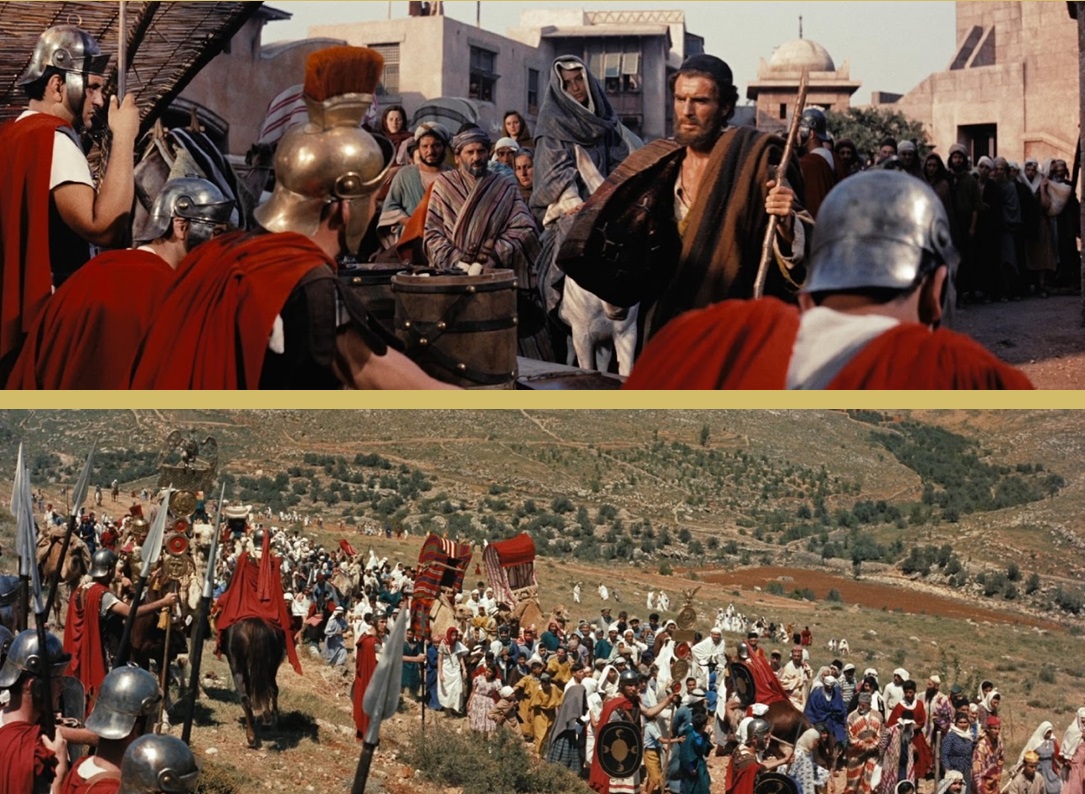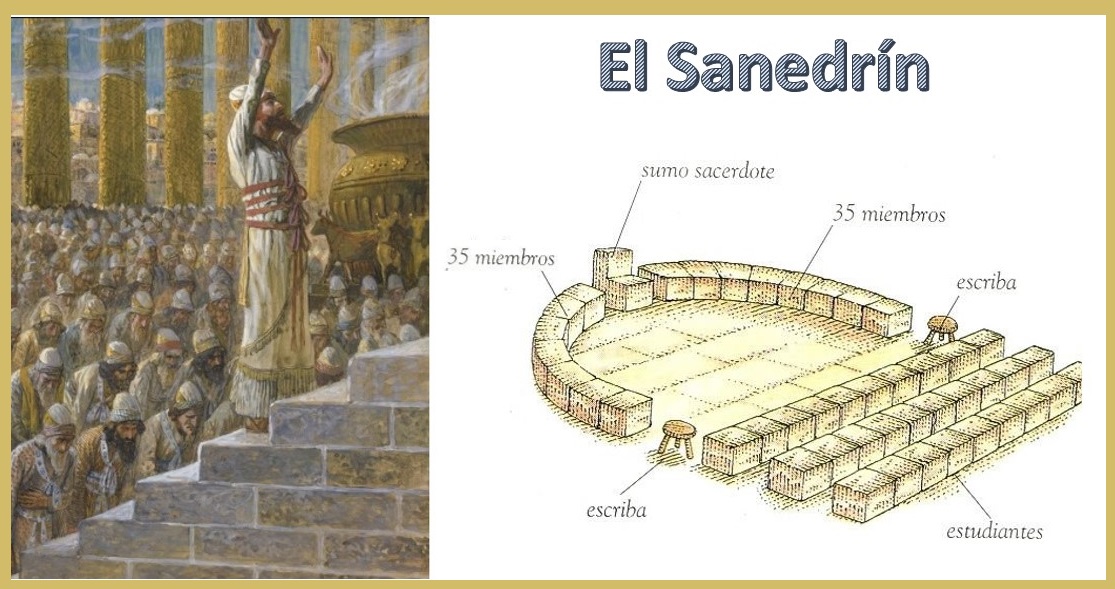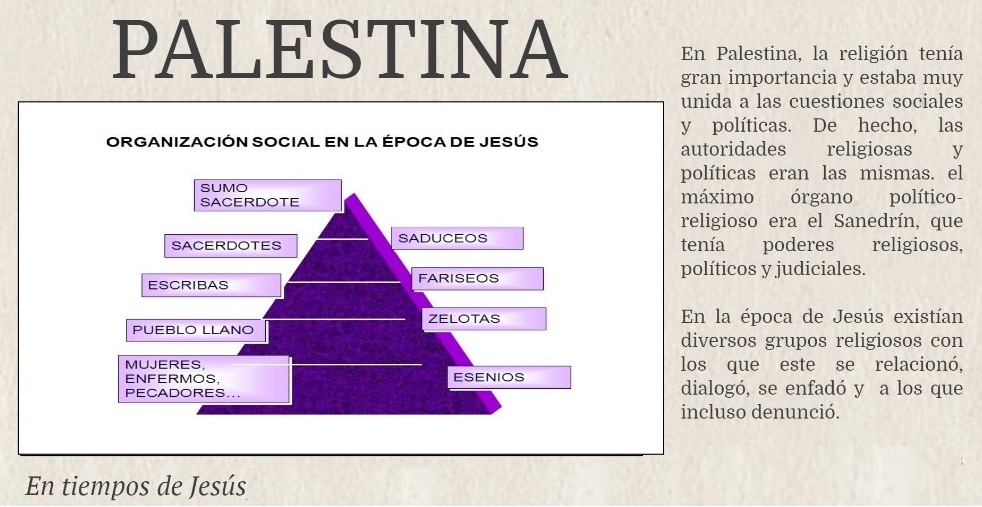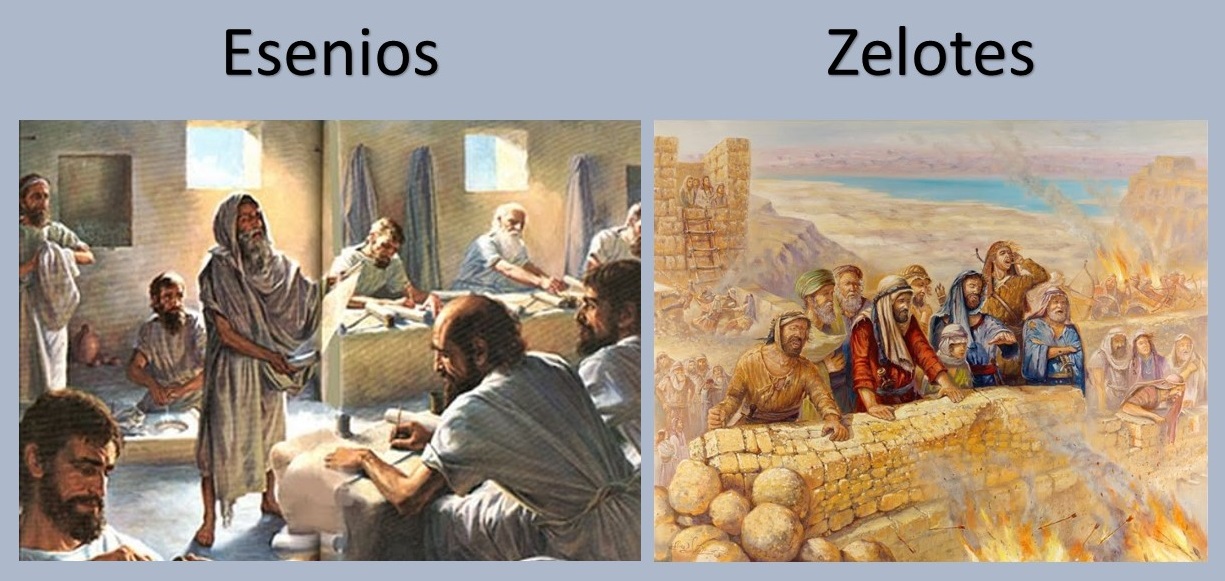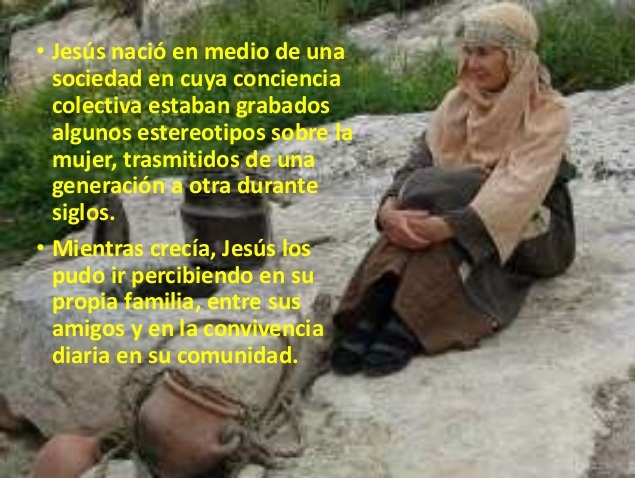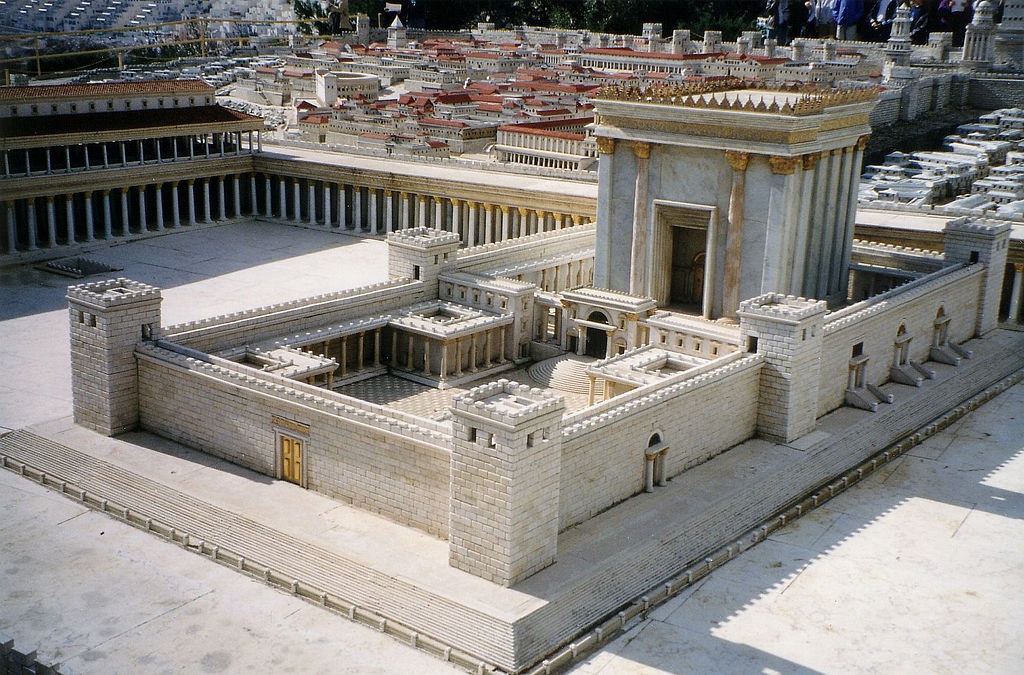Analyze the Map of Palestine at the time of Jesus It has its importance, to understand even more the value of the message and the greatness of the Lord. Regions such as Galilee, the Jordan River, Samaria, and Judea are related to this map. In this opportunity, aspects such as its political organization, theological doctrines, social groups and more will also be discussed.

Map of Palestine at the time of Jesus
Currently Palestine is not recognized as a country within the United Nations organization. Even so, it is considered a territory and the UN admits it only as an observer. However, historically it is considered the Holy Land, this territory that is located between the Jordan River and the Mediterranean Sea. For developing in it most and the most relevant events of the biblical story.
On the map of Palestine in the time of Jesus, different regions of great importance can be observed. Places where the earthly ministry of our Lord Jesus Christ took place.
Mattheww 7:7-8:23 And Jesus went about all Galilee, teaching in their synagogues, and preaching the gospel of the kingdom, and healing every sickness and every disease among the people. 24 And the fame of him spread throughout all Syria; and they brought him all those who had ailments, those afflicted by various diseases and torments, those possessed by demons, lunatics and paralytics; and he healed them. 25 And many people followed him from Galilee, from Decapolis, from Jerusalem, from Judea, and from beyond the Jordan.
Some places on this map and Jesus
The map of Palestine at the time of Jesus contains some places that are mentioned in the gospels to indicate important events about the Lord, such as:
- Bethlehem: Region where the birth of the Lord takes place, Matthew 2:2
- Nazareth: Place where Jesus lives with his parents, Luke 2:39-40
- Jesus is baptized in the Jordan River, Matthew 3:1
- Cana: He performs his first miracle at a wedding (John 2:1-12)
- Jericho: Performs the miracle of healing a blind man (Luke 18:35-43)
- Jerusalem: Here Christ dies and rises (Mark 11:11, 15:22, 16:6)
Therefore the map of Palestine at the time of Jesus is significant in the analysis of the historical Jesus in the Bible. As well as knowing the types of government, social groups, cultures, etc. of that time is of great importance for a better understanding of the Lord's message.
Etymological origin of Palestine
The toponymy or etymological origin of the name of the place known as Palestine, according to some authors, was given by the Romans. Apparently they called this territory or province that way, taking it from the Greek Παλαιστίνη, transliterated into the Latin Palaistine, and whose meaning is Land of the Philistines.
This etymological origin is not very clear, however historically, the Jews and the Philistines in the Bible, from the earliest times have fought for the same lands. There are many struggles between these two civilizations. Which were recorded in several biblical passages. A very relevant one was the confrontation between King David and the giant of the Philistines called Goliath. Check it out by going to this link. David and Goliat: a biblical duel that made history. In this duel, David the anointed by God manages to defeat the giant of the Philistines, hitting him with a stone thrown with a slingshot in his forehead, leaving him lifeless on the battlefield.
During the course of the second century before Christ, the Philistines were dominated by the kingdom of Israel. Later in the first century, all the territory framed on the map of Palestine at the time of Jesus was under the rule of the flourishing Roman Empire, with the city of Jerusalem as its capital.
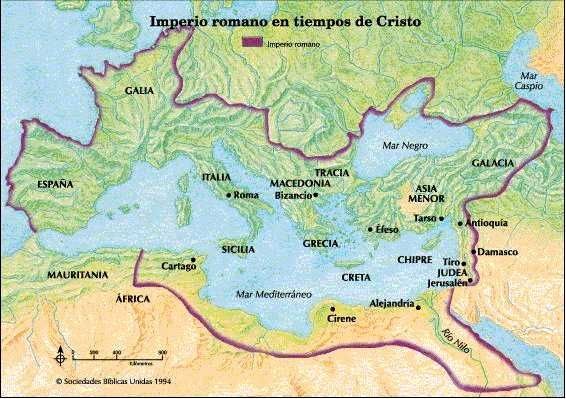
Image No. 1
Historical context of the map of Palestine at the time of Jesus
At the beginning of the first century of the Christian era, the mighty army of Rome came to unite all the regions located in the perimeter of the Mediterranean basin; in a single vast and powerful empire, the Roman Empire, see image No. 1 above. The Romans had managed to consolidate many of these regions, guarding their borders very well.
The Palestinian territory was in this situation since the victorious capture of the city of Jerusalem at the hands of the Roman General Pompey the Great in the year 64 before the Christian era.
The modern empire of that time, of which many archaeological ruins are still preserved. It communicated by diverse and interwoven paths. The same ones that would be used by those who helped propagate a nascent doctrine. The doctrine that announced the messiah, the Savior, the one sent by God. Who had been incarnated, born in a distant corner of the great Roman empire.
God the father upsets the world from the beginning by choosing for the incarnation of his son a distant province of the vast Roman empire, the province of Palestine. And it is that the savior announced by the prophets is not born in any place or at any time.
The reason for that time
God precisely decides the time of prosperity of Rome, in which this civilization had managed to absorb and dominate the Hellenistic of the Greeks. Resulting in a large sum of cultures. This is how the presence of the Hellenic culture together with the Roman allows a better understanding of the message of the Christian gospel, which was already outlined by the evangelist John in the first chapter of his writings.
John 1: 10-14: 10 He was in the world, and the world was made by him; but the world did not know him. 11 He came to his own, and his own received him not. 12 But to all who received him, to those who believe in his name, he gave power to become children of God; 13 Who were born, not of blood, nor of the will of the flesh, nor of the will of man, but of God. 14 And that Word was made flesh, and he dwelt among us (and we saw his glory, glory of him as of the only begotten of the Father), full of grace and truth.
The reason for that place
Although the prophets announced a Savior sent by God to become a man and occupy the position of King of Kings, Lord of Lords. According to this, the world could have thought that God would choose the splendid Rome of that time as a place worthy to be born a man with such majesty and divinity. And if not in any case other of the important cities of the empire of those times. But this is only the conception of the world, but not that of God.
God therefore manages to confound the world by choosing a very small town called Bethlehem located within the territory of the province of Palestine, occupied at that time by the Roman Empire.
About the prophets of the old testament of the Bible it can be said that they were those characters who had a higher level of intercession or a deep intimacy with God. The Lord used these biblical characters as a way to authoritatively inform Israel about his Word. I invite you to learn more about them in the following article, The prophets: Who were they?, minors, majors and more

Image No. 2
The province of Palestine in the times of Jesus
To the east of the Mediterranean basin extends vertically an axis of fruitful land, which the Romans came to call the province of Palestine. This territory from the first years of history was the usual route used by the caravans that moved from Egypt to Mesopotamia, today Iraq. Bordering large stretches of desert along this route, see Image Nº 2 above and the situation of the province of Palestina in the Mediterranean basin below in Image Nº 3.
The province of Palestine, with a geography of generous lagoons in some areas, moderate and arid in many other areas, has a very special feature that distinguishes it. And it is that it is the land promised by God to Abraham himself.
Abraham's descendants at that time made up the people of Israel. Therefore the Jews were clear in defining themselves as the people chosen by the one true God. Jehovah God who brought them out of Egypt guided by Moses, to whom he delivered the law to be given to his people.
Taken by Pompey the city of Jerusalem, capital of the province of Palestine, the Roman general leaves the entire territory subject to Rome. Therefore, the entire population had to pay tribute to Rome.
Pompey, before withdrawing from Jerusalem, leaves a Jew, Herod the Great, as the authority of the province of Palestine. To whom the Roman Senate had granted the investiture of King of Judah, for the decisive support given to Marco Antonio

Image No. 3
Herod the Great
Herod the Great was a vassal king, used by the Roman Empire to rule all the territory of Palestine occupied by Rome. He came to rule Palestine as a vassal king of Judea, Galilee, Samaria and Idumea between the year 37 BC and the year 3. Herod has in the New Testament of the Christian Bible, the authorship of ordering for being the ruler of Judea, the Slaughter of the Innocents, at the time that Jesus would be born, Matthew 2:13-23. This ruler of Judea was bloody cruel, he came to kill anyone who could aspire to his position. He even ordered the death of two of his sons for fear that he might be deposed.
On the other hand, the King of Judah, Herod the Great, promoted large and significant constructions in the territory. He built the maritime city of Caesarea, taking into account to build everything necessary and according to what concerned a Hellenistic city of the time. In the same way, he built an extraordinary and important seaport for that city.
Herod the great within his promotion of works, achievement:
- Rebuild the ancient city of Samaria
- I build great fortresses
- He restored the existing fortresses, in which he built splendid palaces
- He built a theater, an amphitheater and a hippodrome
However, the crowning work of Herod the Great was the reconstruction of the temple in Jerusalem. Reconstruction that he carried out with extraordinary magnificence.
Herod and the Sanhedrin
As for the religious aspect, Herod drastically modified the Jewish Sanhedrin and that corresponding to the position of the High Priest. The position of High Priest before the Herodian government had a lifetime character, was inherited and was the representative of the nation. Herod, in order to have control over the High Priest, suppressed this character as well as removing all influence regarding Jewish politics.
As for the Sanhedrin, I transform it to resemble the council that established the Greek monarchy. So the Sanhedrin was made up of the king's advisers and headed by Herod.
When Herod died
Once Jesus was born, the ruler of all Palestine, Herod the Great, dies, as the Gospel of Matthew says:
Mattheww 7:7-8:19 But after Herod had died, behold, an angel of the Lord appeared to Joseph in Egypt in a dream, 20 saying, "Arise, take the child and his mother, and go to the land of Israel, for those who sought the death of the son are dead." child.
When Herod the Great died, he left the divided kingdom as a testamentary legacy. He divided the territory of Palestine into three, giving a part to three of his sons and none could hold the title of king, they inherit:
- Archelaus: Judea, Samaria and Idumea
- Philippi: Trachonitides and Iturea
- Herod Antipas: Galilee and Perea
This is the moment in which the activity of the historical Jesus begins. Whose most important events in the life of the Lord took place mainly in two regions of the map of Palestine at the time of Jesus: Galilee and Judea. Two regions with political regimes of independent governments, each with its form of command within the Roman Empire.
Matthew 2: 22:21 Then he arose, and took the child and his mother, and came into the land of Israel. 22 But hearing that Archelaus was reigning in Judea instead of his father Herod, he was afraid to go there; but warned by revelation in a dream, he went to the region of Galilee, 23 and came and dwelt in the city called Nazareth, so that what was said by the prophets might be fulfilled, that he would be called a Nazarene.
https://www.youtube.com/watch?v=AIdKx1qKaiE
Map of Palestine at the time of Jesus – The division of the territory
In the times of Jesus when the Christian era begins in the year one. The evangelists of the biblical New Testament make a distinction on one side of the Jordan and the other side, an example of which can be read in:
Mark 6: 45:45 Immediately he made his disciples get into the boat and go ahead of him to the other side, to Bethsaida, while He dismissed the crowd.
The Jordan River apparently established a dividing line between two territories, but at the same time it divided two cultures. The evangelists, when speaking of the other side, made reference to the non-Jewish gentile people, this territory today is known as Jordan, see image No. 4
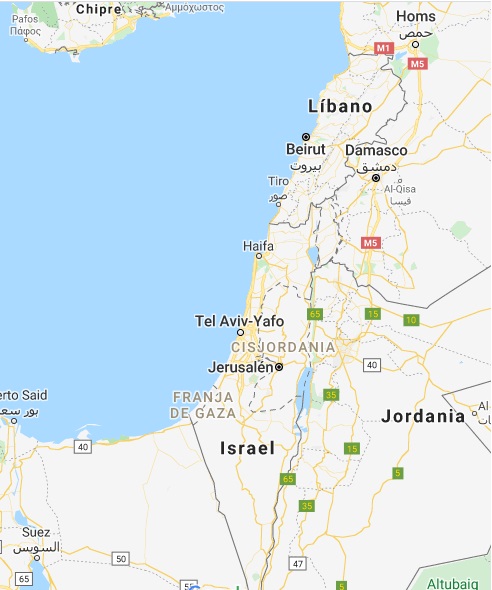
Image No. 4
While the region on the Jordan side was inhabited by the Jewish civilization. Jesus inhabited and lived in the territory located west of the Jordan, today the territory of Palestine. A territory that at that time was under the rule of the Roman Empire. And that throughout history it has had names like: Promised Land, Canaan, Judea, Holy Land, etc. In image No. 5 you can see the towns of Capernaum and Bethsaida separated by the Jordan River.
However, by the year one of the first Christian century, the territory of Palestine was divided into four main regions:
- Galilee
- Samaria
- judea
- Perea
At this time the city of Jerusalem belonged to a province that included, in addition to Judea, Samaria. Province that had been inherited by Archelaus. As for the region of Galilee, where Jesus spent most of his ministry; It was ruled by Petrarch Herod Antipas.
Therefore, both provinces were separated by a different political regime, that even to go from one to another it was necessary to cross a border.
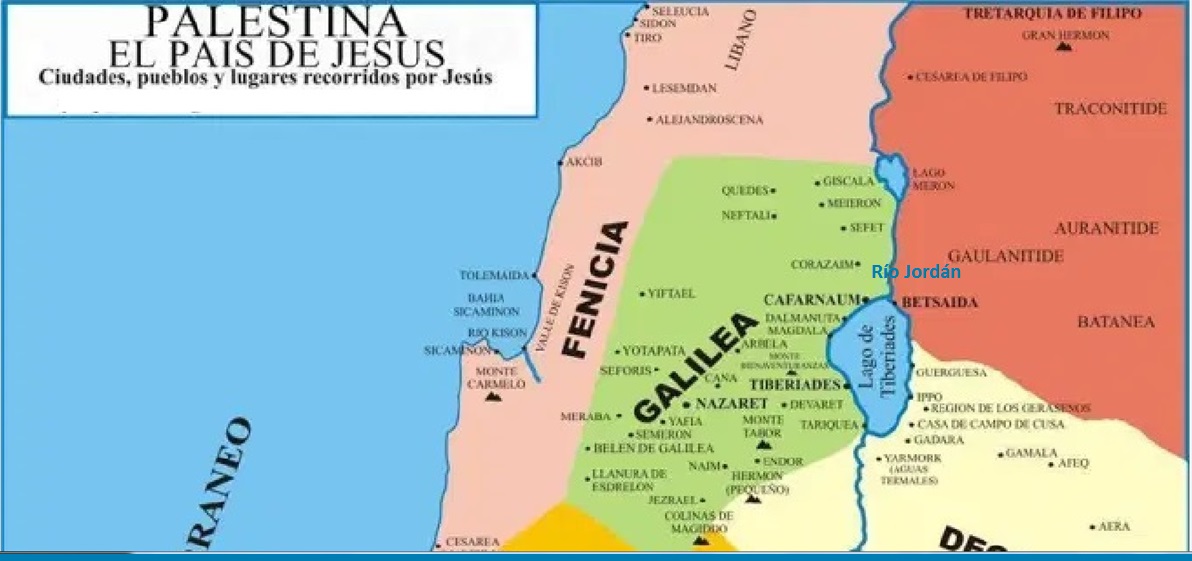
Image No. 5
Galilee
Galilee is the northernmost region on the map of Palestine at the time of Jesus. This region extends from the foothills of Mount Hermon to the Jezreel Valley from north to south. While from east to west, it develops from the Mediterranean Sea to the Jordan River in the Sea of Galilee or Lake of Genesaret.
The geography of Galilee has a relief of hills to the north, cultivated with vineyards and olive groves, in the valley areas it is customary to grow cereals such as wheat and barley. To the east, the land decreases in slopes until reaching the great Lake of Genesaret.
On the shores of this lake and surrounding areas, most of Jesus' earthly ministry was spent. Especially in cities like:
Cafarnaúm
Capernaum is the city where Peter and Andrew two of Jesus' disciples lived. Although Capernaum was not very important as a city, it was in the religious aspect. Since it had one of the most important Jewish populations in Galilee, being a border region.
Capernaum was also next to the road that connected Galilee with the territory ruled by Tetrarch Philip, Traconítide and Iturea. The capital of that territory was the city of Bethsaida, named in the gospels of Jesus.
On the border road that connects Capernaum with Bethsaida there was a customs service and a Roman military garrison. At the exit of Capernaum in the southern direction of the city and close to the banks of Lake Genesaret; you traverse land that is fertile in the spring season, bordering a hill on your right hand side. In this land is located the place where, according to tradition, Jesus transmitted the Sermon on the Mount. At the foot of that mountain, Jesus' miracle of the multiplication of the loaves and fishes took place.
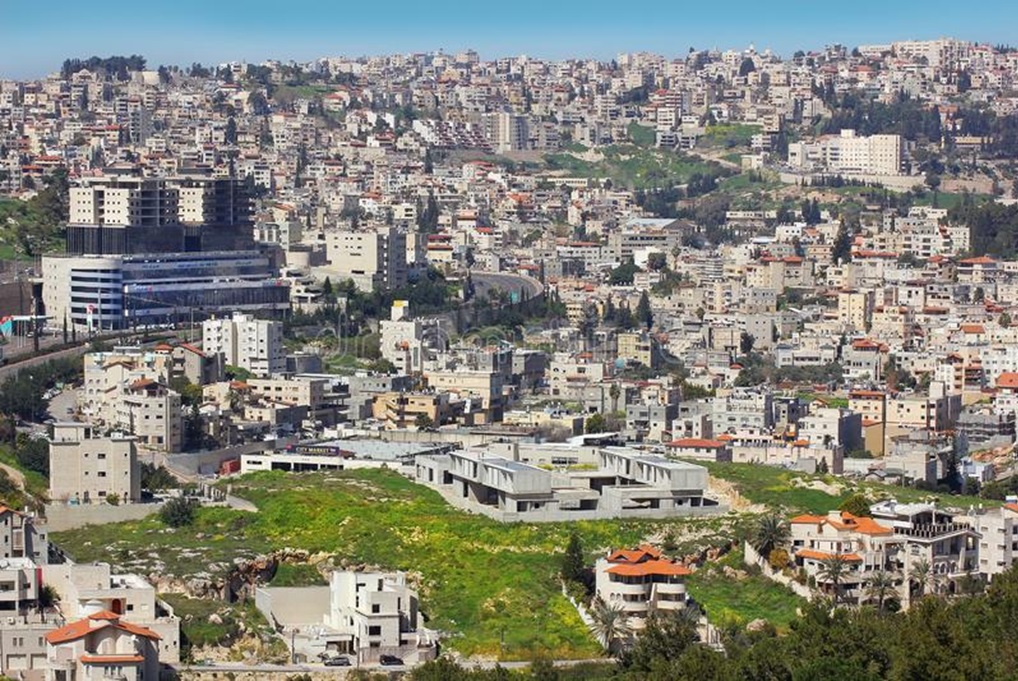
NAZARETH, ISRAEL – Panoramic view of present-day Nazareth, a city in Galilee, northern Israel. Jesus spent his childhood and youth in this city.
Nazareth
Nazareth is located on a fairly fertile plain in a mountainous area near Lake Gennesaret and south of Galilee. In the town of Nazareth, Jesus lived until the moment he began his earthly ministry. Similarly, some of Jesus' disciples were from Galilee.
The Galileans were not well seen by radical Jews, because they had mixed for years with foreign descendants not belonging to the Jewish religion. So fervent Jews called the region The Galilee of the Gentiles.
Aspects or highlights of the Galilee region:
-In the lower part of Galilee is the well-known Sea of Galilee or Lake of Tiberias also or Lake of Genesaret. It is a large lake 21 kilometers long by 12 wide and with a negative elevation of 210 meters below sea level.
-The plain of Gennesaret was a multi-cultural and multi-ethnic region, due to the frequency of caravans passing from Damascus to Caesarea Philippi.
-In Galilee, Mount Tabor, located to the southwest of Lake Genesaret, stands 588 meters above the plain.
-The typical houses of the rural population of the region were small and frequently in one piece.
-Galilea dominated the domain of latifundist land, whose owners could be the king or ruler, his relatives and the rich merchants.
-The settlers of Galilee were Jews, surrounded by pagan peoples. Because of this they were more open to other cultures and customs. The Jew of this area was of a less religious spirit than those of Judea, as regards the observance of the law.
-The Jews of the region of Judea, being more legalistic, considered the Jews of Galilee to be semi-pagan. Because of this the religious scribes, Pharisees and Sadducees, disowned Jesus and his disciples.
-Most of the inhabitants of Galilee were fishermen and peasants by trade. This is why many of Jesus' parables revolved around farming and fishing life. Do you know what these Parables are? Enter this link and know the best parables of Jesus and its biblical meaning. With these brief stories the Lord taught the people and his disciples, so that they could understand the message of God and his Kingdom.
Samaria
North of Judea and south of Galilee can be seen on the map of Palestine in the time of Jesus to the region of Samaria. While to the east and west Samaria is bounded by the Jordan River valley and the Mediterranean Sea. In those times this region was included within the territory ruled by Archelaus son of Herod the Great. A central massif of mountains and low hills make up the nucleus of the population or city of Samaria. This central massif is separated from the Galilee region by the Esdraelon Valley, also called Yesrael.
In the gospels of Jesus it can be seen how the Lord crossed the territory of Samaria several times to go from Galilee to Jerusalem. This was the shortest way, however the Jews avoided it. Due to his antipathy with the Samaritan people for religious and historical reasons.
The journey walking as Jesus did along this path of rugged geography is really relentless, especially in the hottest hours. The road runs through successive hills planted with olive trees, mountains of arid soils and one or another valley covered with ears of wheat. Throughout this route you walk through narrow paths that run through the most accessible steps.
The Valley of Esdraelon
The first name of the Valley of Esdrelón, is that of Plain of Jezreel or Yesrael and can be read in the book of Judges of the Old Testament of the Bible. In these plains the enemies of Israel camped with their tents, which Gideon would later defeat.
Judges 6:33: But all the Midianites and Amalekites and those from the east came together as one, and passing through they encamped in the jezreel valley
The Hebrew term Yesrael has the meaning of "God sowed" and this name was given to the plain by its city with the same denomination. Later in the books of 2 Chronicles and Zechariah, the Valley of Jezreel is named as the field or valley of Megiddo
2 Chronicles 35:22: But Josías did not withdraw, but he disguised himself to fight him, and did not listen to the words of Neco, which were from the mouth of God; and he came to give him battle in the field of megiddo.
Zechariah 12:11: On that day there will be a great weeping in Jerusalem, like the weeping of Hadadrimon in the valley of megiddo.
The denomination of Valley of Esdrelón, is the transliteration to the Greek of the Hebrew Yesrael. The Jewish historian and Pharisee, Flavius Josephus (37 – 100 AD), refers to this plain as: The Great Plain of Samaria. Plain that demarcates the southern limit of Galilee in the town of Iksal and the Nordic limit of Sanaria in the city of Jenin. All the territory between those two cities, is precisely the plain of Esdraelon.
Aspects or highlights of the Samaria region:
-Samaria was inhabited by a multiethnic and multicultural population, a mix between Assyrians and Israelites.
-Between the radical Jews and the Samaritan population a reciprocal hatred had taken root. Because in the year 107 before the Christian era; the high priest of Judea of the Hasmonean family, John Hyrcanus, takes the city of Shechem, capital of Samaria. By taking power of the city Hyrcano destroys the temple of Gerizim.
-The temple of Gerizim is restored in the year 30 a. C., by marrying a woman from Samaria.
-Later in the 6th year of the time of Jesus, the Samaritans greatly desecrated the temple in Jerusalem. The hostility and hatred between the two peoples became more staunch.
-Because of this great hatred and the mixing of the people of Samaria, the Jews considered the Samaritans to be an impure people whose blood was contaminated with that of other foreign peoples.
-The Jews labeled the Samaritans as a heretical people. Therefore they had no dealings with them.
-For their part, the people of Samaria considered themselves the true descendants of the children of Israel. This population was the one that preserved the ancient Hebrew writing, therefore they considered themselves faithful to the Law and authentic Israelites.
The Samarians had their own temple on Mount Gerizim and did not give importance to the one in Jerusalem. In the same way they denied the religion that was professed in Jerusalem.
-In the Gospel of John it shows that if a Jew called another a Samaritan, it was a serious offense at that time. This is why Jesus is insulted by the Jewish leaders:
Juan 8: 48: Then the Jews answered and said to him, Do we not say well, that you are a Samaritan, and that you have a demon?

Jerusalem
judea
South of Samaria can be seen on the map of Palestine in the time of Jesus to the Region of Judea. Which in those times was ruled by the son of Herod the Great, Archelaus. Who a few years later in the year 26 of the Christian era, he was separated from the government due to his multiple setbacks. From there, Pontius Pilate made his presence as prefect of Rome in Judea.
Judea is a region to the south of the territory of Palestine, it has a relief of high and arid mountains. Mountains that make up an abrupt and closed massif. Judea is surrounded by extensive deserts on its eastern and southern sides. His most important city is the capital Jerusalem, which witnessed multiple and relevant events in the life of Jesus during his stay on earth.
Jerusalem
The capital of Judea is Jerusalem, a holy city for the main theological doctrines such as Judaism, Christianity and Muslim. The religious aspect is what gives Jerusalem importance, more than commercial traffic it is the pilgrimage of multitudes of people attracted by what this holy land represents.
To the east of the city you can find the Mount of Olives next to the Kidron Valley. Mount where Jesus used to pray in intimacy with his heavenly father and in which he was handed over, taken as a prisoner.
From the time of Jesus, Jerusalem owed its importance to religious worship. Because the only Jewish temple is located within its territory. So all the Jews of the regions of the map of Palestine at the time of Jesus went on pilgrimage to the city of Jerusalem. In addition, it was also the center of Jewish training. So throughout history, Jerusalem has been linked to its important and imposing temple.
In the surroundings, on the slopes and hills, the houses of ancient Jerusalem offer a beautiful landscape that is very difficult to forget. The Lord Jesus loved his land and his people dearly, as can be seen in his lamentation for what Jerusalem would suffer at the hands of Titus the emperor of Rome when he destroyed it in the year 70 after Christ.
Mattheww 7:7-8 Lament of Jesus for Jerusalem: O Jerusalem, Jerusalem, the city that kills the prophets and stones the messengers of God! How many times I wanted to gather your children like the hen protects her chicks under her wings, but you didn't let me. 38 And now, look, your house is abandoned and desolate. 39 Well, I tell you this: you will not see me again until you say: Blessings to the one who comes in the name of the Lord!

Animated image of the city of Jerusalem and its relevant places in the time of Jesus
In the territory of Judea there are a variety of towns or villages that played a leading role during the earthly life of Jesus. Among these towns are the following:
Belén
About five miles south of Jerusalem is the small town of Bethlehem. This town is made up of grouped houses that give the impression of being painted on the side of a hill. In the times of Jesus the houses of Bethlehem were very humble. And the caves that formed in the hills were used by the settlers as warehouses for crops and stables for animals. It is precisely in one of these caves that was used as a stable, in which our Lord Jesus was born.
At that time Belén was an important village for the trade of goats and sheep. Due to its strategic location between the fertile land and the desert areas of the Judea region. So the shepherds often stayed with their flocks of goats and sheep outside of Bethlehem
The village of Bethlehem is also called by the Jews as the city of David, because it was there that Samuel anointed him as king in the name of God. In the same way in the old testament it is announced by the prophets that the Messiah would be born in Bethlehem, the savior sent by God.
Micah 5:2: A ruler will come out of Bethlehem. 2 But you, O Bethlehem Ephrata, are only a small village among all the people of Judah. However, in my name, a ruler will come out of you for Israel, whose origins come from eternity.
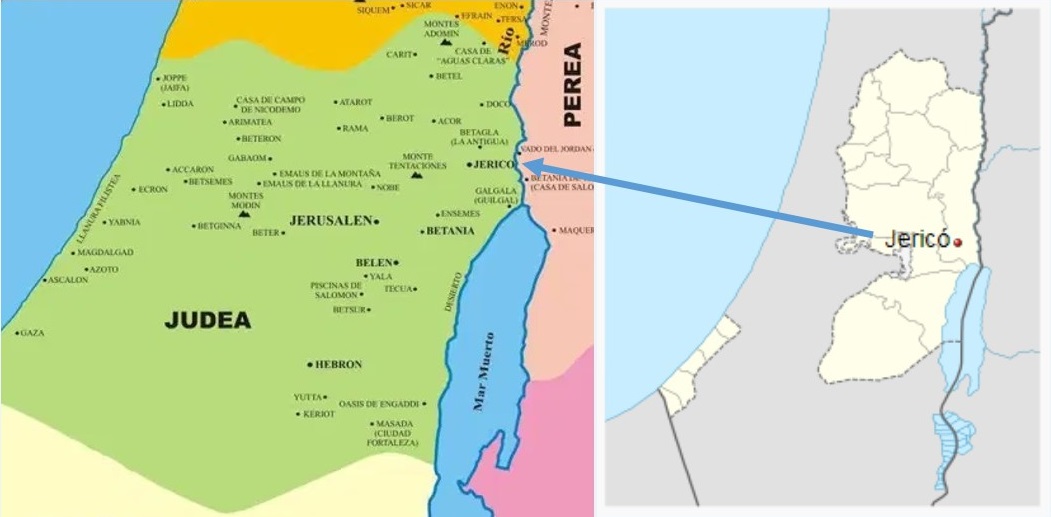
Location of Jericho on the Map of Palestine at the time of Jesus
Jericho
Jericho, one of the oldest cities in the world, is located in the Judea region. According to archaeological discoveries, it is a city that was built between eight and ten thousand years ago. Being its first inhabitants the Canaanite people, descendants of Cam son of the biblical character Noah. This territory is a beautiful oasis with a negative elevation of about 250 meters below the level of the Mediterranean Sea.
Being an oasis, the vegetation found there is exuberant, compared to the desert areas of the Palestinian territory. Jericho abounds with date palms and a large number of leafy trees. In the same way, roses and all kinds of flowers are grown in this city.
The route from Jericho to Jerusalem is one of the busiest in Judah, and it is exhausting as well. Since the thirty kilometers of distance that exist between the two cities, most of it runs through the Judean desert. As well as the height difference that exists between Jericho and Jerusalem, which is more than a thousand meters high. Therefore, to travel this route it is necessary to overcome this difference in height between ascent and descent depending on the direction of the crossing.
Today Jericho is located within the West Bank, very close to the Jordan River and within the territory of Palestine. The city of Jericho is mentioned several times in the books of the Bible. Of which the story of the fall of the walls of Jericho in the book of Joshua stands out:
Josué 6: 20: When the people heard the sound of the ram's horns, they shouted with all their might. Suddenly, the walls of Jericho collapsed, and the Israelites went straight to attack the city and took it.

Old Road from Jerusalem to Jericho, photograph taken in 1932
Bethany
Almost reaching the city of Jerusalem, just three kilometers away, is the village of Betania, developed at the foot of the Mount of Olives. In this small village are located the first sources of water and the first refreshing shade of the trees, after the journey to Jerusalem. Some friends of Jesus lived in Betania, they were three brothers named Lázaro, Marta and María.
Luke 10: 38-42 Jesus visits Martha and Mary: 38 During the journey to Jerusalem, Jesus and his disciples came to a certain village where a woman named Martha welcomed them into her home. 39 Ella's sister Mary sat at the feet of the Lord to listen to her teaching,
John 11: 4-6: When Jesus heard the news, he said, “Lazarus' illness will not end in death. Rather, it happened for the glory of God, so that the Son of God would receive glory as a result.” 5 Although Jesus loved Martha, Mary and Lazarus, 6 stayed where he was for two more days.
The Mount of Olives separates Bethany from Jerusalem. Leaving Bethany towards Jerusalem, you cross a path with fig trees on the sides, then climb a summit from where you get a beautiful image of the city of Jerusalem, the Kidron Valley and the Garden of Gethsemane where ancient olive trees. In the same way you can see the temple that is built there with its immense esplanade and other buildings.
Emmaus
Emmaus was an ancient village within the map of Palestine at the time of Jesus. At present, on the site where the village of Emmaus was located, the population of Imuas is located between eleven and twelve kilometers away from the city of Jerusalem. The ancient village of Emmaus is named in the Gospel of Luke 24:13-35, where the risen Jesus appears to two of his followers:
Luke 24: 13-15 On the way to Emmaus: 13 That same day, two of Jesus' followers were on their way to the town of Emmaus, about seven miles from Jerusalem. 14 As they walked, they talked about things that had happened. 15 While they were talking and talking, suddenly Jesus himself appeared and began to walk with them; 16 but God prevented them from recognizing him.
Aspects or highlights of the Judea region:
-It is a region of large desert areas and has a large closed and rugged massif of mountains.
-In Judea wheat is grown in small quantities, but it is a great producer of olives, grapes, dates, figs and legumes.
-The inhabitants of Judea at the time of Jesus were mostly from a poor social stratum. Their type of diet consisted mainly of fish and very little meat.
-In the times of Jesus almost all livestock production was destined for the temple sacrifices.
-The capital of Judea, Jerusalem was the holy city of the Jews, it was a city with little commercial traffic, its importance was due to religious reason.
-In Judea, specifically in Jerusalem, the only Jewish temple in the world was located and to which the Jews went on pilgrimage.
-The temple in Jerusalem was the center of religious training and the seat of the highest Jewish religious authority.
– In Judea there are different towns of great relevance in the earthly ministry of Jesus
Perea
Perea was a region at the time of Jesus that together with Galilee formed part of the territory inherited by Herod Antipas from his father. Who governed it as tetrarch until the year 39 after Christ. This region can be seen on the map of Palestine in the time of Jesus on the east side of the Jordan River, with the regions of Samaria and Judea as neighbors on the other side of the River. The denomination of Perea comes from being the Country beyond, since it was the furthest territory from the kingdom of Judah and its king Herod the Great. Today the territory that was called Perea is called Jordan.
Perea was Canaanite territory until 1400 BC. Later recovered from the Ammonites in 1300 BC, under the Canaanite king Sihon of Hesbon. One hundred years later the territory was dominated by the kingdom of Israel until the middle of the ninth century, when the Ammonites seized the lands of the Perea region.
Centuries later, in the year 160 BC, the Jewish movement of the Maccabees took possession of this territory until the rule of the Roman Empire was established in all the regions of the Mediterranean basin. Perea became the domain of Rome in 63 BC. The main cities of the Perean region were Amathus and Betharamphtha, and their territorial limits were:
- North: The city of Pella of the Decapolis region
- East: The cities of Gerasa and Philadelphia of the Decapolis region
- South: The Moab region
- West: The Jordan River
Model of the Temple of Jerusalem from the Herodian period (XNUMXst century BC – XNUMXst century AD), at the Israel Museum.
Form of government on the map of Palestine at the time of Jesus
Before the birth of Jesus in the year 63 of ancient time, the Roman general Pompey the Great or Pompey the Great, takes the city of Jerusalem. Thus conquering Palestine for the empire. Herod the great who had been governor of Galilee gets Mark Antony to name him and his brother Tetrarchs of Palestine in the year 41. Because at that time Mark Antony owned the eastern part of the empire.
In order to control small territories in the Middle East, the Romans used vassal kings. Herod the Great was one of those men used by Rome. The Roman Senate appoints Herod the Great as King of Judah, ruling all of Palestine from 37 BC, although other authors say it was from 39 AD. Herod was of Edomite descent, but his father had converted to Judaism , therefore he was raised as a Jew.
For the year 31 before Christ, Octavio Augustus is emperor of Rome, Herod manages to get the new emperor to ratify him as king of Judah. Shortly after Jesus was born, Herod dies and leaves three of his sons in charge of the government of the kingdom of Judah. A kingdom that had been divided by Rome into regions, thus converting the government of Palestine into a tetrarchy in charge of the heirs of Herod:
- Archelaus: Governs Judea, Samaria and Idumea, between the years 4 and 6 of the time of Jesus. This ruler is dismissed and replaced by Roman procurators, Pontius Pilate was one of them between the years 26 and 37 after Christ
- Philip: Ruled Traconítis and Iturea between the years 4 and 34 after Christ
- Herod Antipas: Ruled Galilee and Perea between 4 and 39 AD
The Policies of Rome in the Government of Palestine
At the time Jesus is born, Rome is ruled by the Emperor Octavio Augusto. Who remains in office until the year 14 of the Christian era. By the time of the event of the death and resurrection of Jesus, Rome is ruled by Tiberius. Who holds the position of Emperor of Rome from the year 14 to 37 after Christ. Some of the policies of the government of Rome on Palestine are the following:
- It allows local customs to be maintained.
- Foreign policy decisions are reserved
- It controls the currency, the roads and demands payment of high taxes.
- It uses vassal local authorities and loyal to the empire to exercise internal politics
- It allows ordinary justice to be controlled by the Sanhedrin and the High Priest. The Sanhedrin was a kind of Jewish council of wise men. Which was presided over by the High Priest and Jewish leaders or rabbis. This was the court and the High Priest served as judge.
- Only the procurator of Rome was the one who had the authority to sentence the death penalty.
-The Procurator of Rome had his residence in the city of Caesarea. He only went to Jerusalem on special occasions. During his stay in the capital of Judea he stayed in the military citadel known as Torre Antonia, located in the northeast part of the Jerusalem Temple.
Religious worship on the map of Palestine at the time of Jesus
The religion that prevailed in the regions of the map of Palestine at the time of Jesus was the Jewish. This was a religion where only the male assumed roles of importance. Even inside the temple and the synagogue, the women had to remain separated from the men, they came to occupy secondary places in the synagogue.
It was a totally patriarchal religious society, the cult could only be celebrated if there was the presence of at least 10 Jewish men. Regardless of whether women managed to exceed this figure.
Jewish men from different regions of Palestine were required to make a pilgrimage to the temple in Jerusalem during Jewish celebrations. While it was not compulsory for women to go on pilgrimage, they only did so if they wanted to.
For both men and women it was mandatory to comply with the law of the Torah given by God to Moses to be fulfilled by the Jewish people. The Jewish authority that ensured compliance with the law of the Torah was in charge of the Sanhedrin.
The Sanhedrin
The Sanhedrin was a kind of Council or Cabildo and was the organization that exercised authority within the Jewish religion. This Sanhedrin was made up of 71 members, presided over by the High Priest.
All the members of the Sanhedrin sat in a semicircle, with the High Priest standing in the middle of them. In addition to the 71 members, there were two Jews who served as scribes on the council. Which took notes sitting on stools in front of the semicircle formed by the members of the Sanhedrin.
The members of the Sanhedrin were mostly from the religious group of the Sadducees. This group were priests, rich and of great power within the Jewish community. The rest of the members belonged to the religious group of the Pharisees.
The Sanhedrin executed justice according to the Jewish law of the Torah, having jurisdiction in everything related to religious practice and worship, as well as everything derived from Jewish law. Therefore the Sanhedrin had the power to judge, punish and imprison. However, the government of Rome imposed that only the Roman authority was the one that could impose the death penalty or sentence.
The High Priest
The high priest was the highest authority within the temple and held the position of president of the Sanhedrin. Such authority gave him the enjoyment of having power and an excellent economic position. The high priests were chosen from the religious party or group of the Sadducees. They collaborated with the Roman authority.
The position of the High Priest maintained its character for life until the arrival of Herod the Great as king of Judah. When Rome established the Roman procurators in Palestine, they had the power to appoint and dismiss the High Priests at the time they so required. In the times of Jesus, the Sanhedrin was under the power of two High Priests, these were:
- Annas: from the year 6 to the year 15 of the Christian era
- Caiaphas: from the year 16 to the year 37 after Christ. This high priest was the son-in-law of his predecessor and was also the one who accused Jesus before the Procurator of Rome Pontius Pilate.
John 18: 28-31 Jesus before Pilate: 28 They took Jesus from the house of Caiaphas to the Praetorium. It was morning, and they did not enter the praetorium so as not to contaminate themselves, and thus be able to eat the Passover. 29 Then Pilate went out to them, and said to them, What accusation do you bring against this man? 30 They answered and said to him, If this man had not been a criminal, we would not have handed him over to you. 31 Then Pilate said to them, Take him yourselves, and judge him according to your law. And the Jews said to him: It is not lawful for us to put anyone to death;
Map of Palestine in the time of Jesus and the religious groups
The people who inhabited the regions of the map of Palestine at the time of Jesus came from various civilizations. However, the majority was of a religious nature, highlighting the Jewish religion, especially the inhabitants of Judea and Galilee. As for the inhabitants of Samaria, they considered themselves Jews for the most part, although for the Jews of the region of Judea they were pagans.
The Jews considered themselves a special people, a holy people, because God had established a covenant with them through the Mosaic law. But by the time of Jesus different religious groups or societies had been established. In which each of these groups had their own interpretation of the way they should live, their own interpretation of the law and therefore their fidelity to God.
The most important of these Jewish religious groups or societies were the Pharisees, Sadducees, Essenes, and Samaritans. Even in the gospels of the life of Jesus, the relationship of some of them with the Lord and their discrepancies on some aspects of the particular teachings of each one are mentioned.
Mattheww 7:7-8: 1 Then Jesus spoke to the crowds and to his disciples, saying: 2 On the chair of Moses sit the scribes and the pharisees. 3 So whatever they tell you to keep, keep it and do it; but do not do according to their works, because they say, and do not. 4 Because they bind heavy and difficult loads, and put them on the shoulders of men; but they don't even want to move them with a finger.
Mattheww 7:7-8:11 How is it that you do not understand that it was not for the bread that I told you to beware of leaven? of the Pharisees and the Sadducees? 12 Then they understood that he had not told them to beware of the leaven of bread, but of the doctrine of the Pharisees and Sadducees.
In addition to the aforementioned groups, there were also religious societies such as: the elders, the priests, the scribes and the Zealots.
The Sadducees
Within the group of society in the times of Jesus called the Sadducees, there are some characters who all came from the lineage of the tribe of Levi. They were also descendants of the priestly branch of the sons of Aaron specifically. Including a possible first high priest, who would be Zadok.
It is from there that its denomination is derived, which was firstly Sadducines, passing through Saducayans, until finally defining itself as the Sadducees. This social and religious group focused on fulfilling the law of the Torah. Especially to what has to do with the sacrifices, described in the biblical texts of the exodus, Leviticus and numbers.
For them that was what they had to fulfill, what they had to do, was to worship God. Sanctifying, manifesting the sanctification of the people of Israel through those permanent sacrifices, the burnt offerings and everything around the temple.
Because the Sadducees carried out the Judaic religion fundamentally everything that revolved around the temple. It made them to be defenders of religious social stability and therefore they used to get along very well with the state authorities. Although the Sadducees had not gotten along very well with Herod the Great, they nevertheless got on very well with the Romans in general. In the same way they did it in part with the Hellenistic society, the Greeks.
For the Sadducees, just being very aware of fulfilling everything that the sacrifices meant; the rest of Jewish life did not attach so much importance to them. In other words, they considered the revelations given by the prophets and the rest of the scriptures to be of second order. Therefore they focused on what was written in the pentateuch of Moses, little was said about the prophecies.
the Pharisees
As for the Pharisees, they gave great importance to the rites on the purifications of daily life. Even those that had to be done outside the temple, especially the washing with water, therefore for them the washing of the hands before meals was of the utmost importance. On this subject, these characters can be found in the gospels contending with Jesus and his disciples. Because apparently, they did not give them the same importance, they said that for Jesus and his disciples, all these things of purifications were trifles at all times.
For the Pharisees it was very important to obey God's law, the Torah. Everything written in the pentateuch had to be fulfilled to the letter. Above all, they gave excessive rigor to everything that was described there about purifications. In fact, from theology, something that characterized the Pharisees was the sacred character that they conferred on the law of the Torah. To which they granted an almost divinity level.
For the Pharisees, the first thing that God creates, even before the creation of the world, is the law of the Torah. And that this law in a certain way functions as a filter through which God carries out the creation of the world. Thus, all the reason for the Torah is imprinted on all things created by God.
Another particularity in the beliefs or doctrines of the Pharisees is to believe in a certain way in a kind of life after death and in a judgment by God. Where he will reward or punish the works of each person. For the Pharisees, then, they had the conception that in the heavens God stores the good works of each person. So that in the end, he will make a count of the people who were better and with more good deeds than bad deeds.
The Pharisees, their relationship with the Roman people and authorities
The Pharisees had a great influence among the people of the regions of the map of Palestine at the time of Jesus. People admired the learning of the Pharisees, so at that time the scribes were usually Pharisees. Regarding their behavior in the face of the political situations in which the territory of Palestine lived at that time, there was a certain division between them. Because for most of the Pharisees they thought that absolute sovereignty belonged to God. And that there was no particular inconvenience, that in everyday life the government could be run by other authorities, even if they were not Jewish. As long as these authorities were tolerant before the law of God. In Jesus' time the Pharisees had a relatively open relationship of collaborating with the Roman authorities.
the essenes
The Essenes were a religious group that lived a monastic life, settling in the town of Qumran on the shores of the Dead Sea. They believed in what was announced by the prophets and expected two types of messiahs, one political and the other religious. Who would come to restore justice in the world, redeem sin and restore the kingdom of Israel.
The documents found in the Dead Sea near Qumran speak of the customs and beliefs of this religious group. Something relevant in the Essenes is especially their break with the priesthood of the temple. Because these considered that the priesthood had been corrupted at the time of the Hasmonean reign. Therefore they made an unworthy cult to which they could not congregate. In view of this, the Essenes break with the priesthood of the temple and go to the desert, so as not to contaminate themselves with ordinary people through commercial relations.
The Essenes thus maintained this separation from the outside world so as not to damage the ritual purity that they wanted to experience even in the smallest and deepest details. And by breaking all ties with the temple in Jerusalem, the Essenes see themselves as a spiritual and living temple; until the time has come for the reconstruction and restoration of pure and legitimate worship.
The Zealots
Although the Pharisees were a collaborating group with the Roman authority, there was another Jewish society that considered that this collaboration could not be possible in any way with a regime that was not proper to Israel. The group that had these conceptions were the Zealots. Which began to form as a result of Roman rule and emerged from the society of the Pharisees.
Therefore, the Zealots were a group of men from the Pharisees, who considered that they could not be granted the exercise of sovereignty to those regimes that were not capable of recognizing the total and absolute sovereignty of the only God, the God of Israel. As the regime of Roman rule passed, the Zealots became more and more radical in their position. They were convinced that the kingdom of God would be brought about in practice through the Lord's own action. And that they were required to collaborate with the Lord to engage in an armed struggle, as the ancient Jewish people were used to.
In this way, a rebellious and insurrectionary movement against the Roman authorities was nourished in the Zealots. The Zealots at the beginning of Roman domination did have some following among the local people. But as time passed, the living conditions of the local people were undermined. Having more hunger, paying extremely high taxes, poor agricultural and commercial situation. So merchants from the Galilee region joined the cause of the Zealots, as well as other sympathizers. These Zealots came to battle with the Roman authorities at the time of Jesus. Even a few years later they managed to establish a revolution against Rome shortly before the year 70 after Christ.
The Samaritans on the map of Palestine at the time of Jesus
After the fall of the northern kingdom at the time of the Assyrian kings between the eighth and seventh centuries BC. The tribes of Israel belonging to the northern kingdom are deported to live in exile in the region of Nineveh. These are the tribes of Israel that history considers to have been lost and they are the ones that seem to repopulate the entire area of the northern kingdom when they came out of exile. Fundamentally the territory of the Samaria region. A repopulation that is carried out with people of different origins, mixed among them.
At the end of the captivity of the Jews in Babylon and return to Jerusalem, they begin the restitution of the temple. The inhabitants who had repopulated the region of Samaria go to Jerusalem and offer their help to the Jews. But the newly arrived Jews from exile consider the Samaritans to be practically gentiles or pagans. So they spurn the help, telling them they don't want anything coming from them, they don't want to mix with them. This is how the distancing, separation and contempt that Jews and Samaritans will have originates.
The temple of Guerizin
As the years passed and in view of the fact that the Jews did not allow the Samaritans to approach the temple in Jerusalem. The Samaritans build a small temple around Mount Gerizin.
Later around the first century before Christ, the high priest of Judea Juan Hircano destroys the temple of Gerizín. With this fact the aversion between Samaritans and Jews becomes greater.
When the Samaritans found themselves without a temple, they continued to practice their rites in the open air around Mount Gerizín and, in turn, did not look favorably on the Jews who passed through their land. While on the side of the Jews they acted in the same way with the Samaritans, considering them pagans and without knowledge of the law of the Torah.
However, the Samaritans kept what was called the Samaritan Pentateuch. Made up of the five books of the law but with certain differences from the true pentateuch of Moses. Especially with what was said about the centralization of the temple.

On the left a Samaritan High Priest with the old Pentateuch, in 1905, and on the right a Samaritan and the old Samaritan Torah
Social classes on the map of Palestine at the time of Jesus
At the time of Jesus, people from two different cultures lived in Galilee. A good part of the population was made up of people of Hellenic culture who spoke Greek. These people were from a social class that lived mainly from commerce and industry. In the same way they stayed in the big cities like Sepphoris or Tiberias.
The other part of the people of Galilee was the predominantly Jewish rural population. These spoke Aramaic and lived in country houses in villages or small towns in Galilee. Some of these localities are usually named in the gospels, such as Nazareth, Cana of them is very familiar to the readers of the gospels, Nazareth, Cana, Chorozaim, etc.
It is not very clear in the New Testament scriptures that there was frequent contact between the population of Greek culture and the population of Jewish culture who lived in Galilee. But the scriptures of the gospels do reveal very clearly that Jesus was in Capernaum, Corozaim, Bethsaida, Cana, Nazareth. All these populations in the same way the archaeological excavations show that the people who lived there were Jews.
However, there is no such certainty that Jesus has been in the interior or remained in cities with a Hellenistic population. Such as Caesarea Philippi, Tyre, Cidon, Ptolemaida, Gádara. Of these cities, Sepphoris is very striking, at that time it was a large city with a large number of inhabitants, and it was an hour's walk from Nazareth. And despite this, it is never mentioned in any of the gospels, nor that Jesus has been or passed through there. As for the other cities inhabited by the Greeks, in the scriptures it is said, for example, that Jesus:
- He was in the confines of Caesarea Philippi
- He went to the region of Tire and Cidon
- He headed towards Tiberias and Gadara
But at no time is it written that Jesus was in those cities. This reflects an attitude in Jesus that suggests a lack of consideration at that time towards the Hellenistic population. What it does reveal is the progressive plan of the Lord's providence that was to begin as it began in the Old Testament by God's chosen people.
Jesus, therefore, addresses himself first of all to the people of Israel, who are the ones who can know his message well. Because they know what was preached by the prophets and the books of the law of the Torah. The second stage of the message of Jesus would correspond to the apostles and the nascent church of Christians to reach the gospel and the preaching of our Lord Jesus Christ to all other people and all other cultures.
The woman on the map of Palestine at the time of Jesus
Palestinian society at the time of Jesus was totally patriarchal. This was a culture passed down from the beginning of the world from generation to generation. Households were made up of large families, since it was lawful for a man to have more than one woman. Being able to all of them together in the same house with the husband. Therefore the woman occupied an insignificant role compared to that of the man. Here are some relevant aspects regarding women in the time that Jesus was on earth:
-To refer to a family, mention was made of the house of the father of that family. Since the father was the Lord of the house and responsible for the assets of that home.
-Only male descendants could inherit the family assets. Well, the daughters only contributed to the family what corresponded to the dowry that the husbands paid to the father at the time of marrying them.
-Women owed their lord the same way a slave or a child under thirteen did. Therefore, when single, the woman was subject to her father, when married she was subject to her husband, and if she became a widow she had to marry her husband's brother and be subject to him. As it was written in Deuteronomy 25:5-10.
-The woman was destined to ignorance, in addition she could not receive religious education, because according to the men she did not have the capacity to understand the teachings. Therefore the schools were only for men.
-Women were considered impure during their period of blood flow. During that time the man could not approach them, nor touch them. When the woman gave birth she had to go to the temple and offer a sacrifice to God, in order to be purified. According to what is written in the book of Leviticus 12, about the purification of women after childbirth
-The woman was not in the capacity to request a divorce, this could only be done by the husband by publicly repudiating the woman, demanding to divorce her.
Jesus and the woman
Jesus during his earthly ministry was no respecter of persons, he treated all equally without distinction of sex and all the people were within the reach of their call to conform the Kingdom of God. He always made it clear that women should be treated with respect and consideration. This could be manifested in that among his followers there were both men and women.
Jesus had the woman in the same position and with the same rights as a man. Therefore, he publicly opposed laws or customs that could make women look like second-class human beings. In the Bible you can find different passages where Jesus gets involved in defense of a woman, such as:
- The Samaritan woman in John 4:4-42
- Martha and Mary, and their friendship with Jesus in Luke 10:38-42
- Jesus forgives a sinner, Luke 7:36-50
- Women who served Jesus, Luke 8:1-3
- Jesus heals a woman, Luke 8:43-48
The Temple of Jerusalem on the map of Palestine at the time of Jesus
The temple of Jerusalem was the most important building for the Jewish people of Palestine at the time of Jesus. Within its walls worship was celebrated to Yahweh, the only God, the God of Israel. In the same way inside the temple of Jerusalem the priests carried out the sacrifices. The Jerusalem temple itself represented God's presence among his people.
The Jewish men of all the regions of the map of Palestine in the times of Jesus had to make an annual pilgrimage to the temple of Jerusalem, generally during the celebration of Passover.
By the time of Jesus the State of Palestine was fundamentally of the theocratic type. With religion occupying a leading role, religious leaders enjoyed great power and authority over other institutions, as well as over the people in general.
The reconstruction of the temple
It was Herod the Great who carried out the task of rebuilding the Temple in the year 19 BC, being the king of Judah. The reconstruction was carried out on the foundations of the first temple initially built by the Israelite kings David and his son Solomon.
The temple was made up of an extensive esplanade with an area of 480 x 300 meters. Which was surrounded by a fairly high wall. The ruler Herod gave the temple great magnificence by covering it with marble and gold, to give it an appearance worthy of divine power. In the Bible, the following can be read in the Gospel of Mark:
Mark 13: 1: Leaving Jesus from the temple, one of his disciples said to him: Master, look what stones, and what buildings.
The temple had large gates, nine in all, and eight of those gates were overlaid with gold and silver. In the same way, the lintels of these doors shone with gold and silver. Only one door was covered with sheets of bronze from Corinth. Giving it an even higher value than the other eight. It also displayed gold and silver in other parts, such as some gates, candlesticks, the sacred utensils used in Jewish sacrifices and rites.
The temple rebuilt by Herod is looted and destroyed after the fall of Jerusalem in the year 70 after Christ, as Jesus would have prophesied during his earthly ministry.
Mark 13: 2: Jesus, answering, said to him: Do you see these great buildings? There shall not be left one stone upon another, which shall not be overthrown.
The Offices in the temple
Two offices or cults were held daily in the temple in Jerusalem. The first was done in the morning and the second in the afternoon. In the special celebrations of the Jewish tradition a special office was performed. Among these celebrations or Jewish holidays can be mentioned:
- Jewish Passover or Pesach
- Shavuot or the Feast of First Fruits
- The Feast of Tabernacles or Sukkot
For these celebrations the presence of every Jewish male over thirteen years of age was mandatory. Above all, men who lived in lands far from Jerusalem had to attend for the Jewish Passover.
The temple was also a teaching center, where religious science, theology and Jewish justice were taught. In the times of Jesus, he used to teach in the Temple, and in the different synagogues of the region. That they were a kind of branch of the temple and a meeting place of the Jews for prayer, as well as for the study of the Law.
